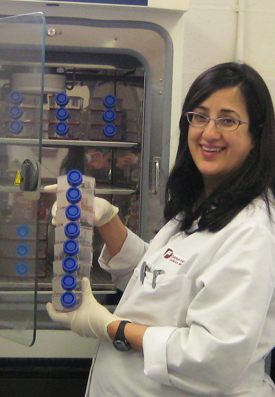The Research Question
To infect cells, the gp120 protein on the HIV envelope initially makes contact with CD4, a protein receptor on the surface of target cells. This first contact with CD4 causes the viral gp120 protein to change its shape—facilitating entry of the virus into the cell. There are currently two FDA-approved drugs that can block this process—maraviroc and enfuvirtide—and the search for more drugs in the same class (entry inhibitors) continues. One candidate, MF275, was the object of this study.
Findings
 Dr. Navid MadaniThe researchers investigated the ability of MF275 to block infection by a variety of different strains of HIV. In some cases, the drug blocked entry effectively. In others, however, the drug not only failed to block entry, it increased the rate of infection. Of particular note to researchers were cells that lacked the CD4 receptor—thus not usually susceptible to HIV infection—in which the drug enabled rather than blocked infection.
Dr. Navid MadaniThe researchers investigated the ability of MF275 to block infection by a variety of different strains of HIV. In some cases, the drug blocked entry effectively. In others, however, the drug not only failed to block entry, it increased the rate of infection. Of particular note to researchers were cells that lacked the CD4 receptor—thus not usually susceptible to HIV infection—in which the drug enabled rather than blocked infection.
Impact
While this effect may be a setback for drug development, it does point to potential new research directions. First, it exposes loopholes that HIV can use to infect host cells that should be fixed in future rounds of drug development. Second, it illuminates the diverse routes HIV uses to enter cells, information that could aid in discovery of new types of entry inhibitors or other ways to block HIV infection, such as antibodies.
amfAR’s Role
amfAR funds two of the researchers involved in this study, Drs. Alon Herschhorn of the University of Minnesota and Navid Madani of Harvard Medical School.
Original Article
http://www.ncbi.nlm.nih.gov/pubmed/31391272
Dr. Laurence is amfAR’s senior scientific consultant.